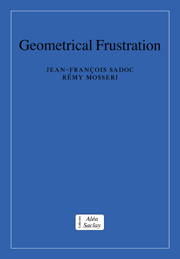Book contents
- Frontmatter
- Contents
- Preface
- 1 Introduction to geometrical frustration
- 2 Ideal models
- 3 Finite structures
- 4 Decurving and disclinations
- 5 Hierarchical polytopes
- 6 Some physical properties
- 7 Periodic structures with large cells
- 8 Quasiperiodic order and frustration
- A1 Spaces with constant curvature
- A2 Quaternions and related groups
- A3 Hopf fibration
- A4 Polytopes and honeycombs
- A5 Polytope {3, 3, 5}
- A6 Frank and Kasper coordination polyhedra
- A7 Quasiperiodic tilings: cut and projection
- A8 Differential geometry and parallel transport
- A9 Icosahedral quasicrystals and the E8 lattice
- Bibliography
- Index
A6 - Frank and Kasper coordination polyhedra
Published online by Cambridge University Press: 06 January 2010
- Frontmatter
- Contents
- Preface
- 1 Introduction to geometrical frustration
- 2 Ideal models
- 3 Finite structures
- 4 Decurving and disclinations
- 5 Hierarchical polytopes
- 6 Some physical properties
- 7 Periodic structures with large cells
- 8 Quasiperiodic order and frustration
- A1 Spaces with constant curvature
- A2 Quaternions and related groups
- A3 Hopf fibration
- A4 Polytopes and honeycombs
- A5 Polytope {3, 3, 5}
- A6 Frank and Kasper coordination polyhedra
- A7 Quasiperiodic tilings: cut and projection
- A8 Differential geometry and parallel transport
- A9 Icosahedral quasicrystals and the E8 lattice
- Bibliography
- Index
Summary
Frank and Kasper polyhedra
One can always, in an unambiguous way, divide up a structure, made of points, into (usually irregular) tetrahedra. This is done using first the Voronoi (or Dirichlet) decomposition of space into individual cells which contain the regions of space, closer to a given point than to any other one. In generic cases, the Voronoi cells have three faces sharing a vertex of the cell. Then, connecting the original points of the set whenever their associated Voronoi cells share a face, defines a unique decomposition of the space into tetrahedra. This simplicial decomposition is equivalent, in three dimensions, to a point set triangulation in two dimensions. This procedure also provides the best way to define the coordination number in dense structure: it is the number of faces of the Voronoi cell. In a topological sense the Voronoi cell and the coordination polyhedra are dual. In a tetrahedral division of space, the set of vertices closest to a given site form its first coordination shell, which is a triangulated polyhedron (a deltahedron).
Let us introduce now a standard notation for a site coordination in a tetrahedrally close-packed structure. If the tetrahedra are not too distorted, we can only find situations where either five or six tetrahedra share a given edge. This is the case considered by Frank and Kasper (1958), who then proposed the following notation: a site such that its first neighbour shell is an icosahedron (allowing for small distortions) is called a Z12 site.
- Type
- Chapter
- Information
- Geometrical Frustration , pp. 255 - 262Publisher: Cambridge University PressPrint publication year: 1999



